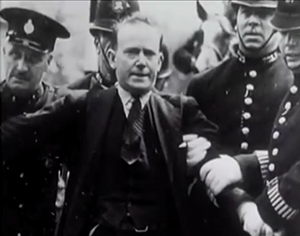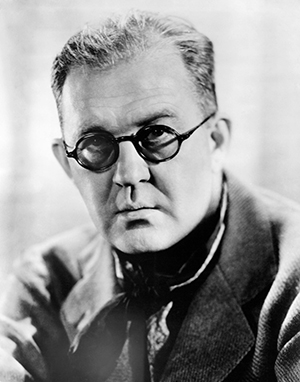ON THIS DAY
Published in Issue 4 (July/August 2018), News, Volume 26BY AODHÁN CREALEY
JULY

Above: George McMahon (born Jerome Bannigan) is led away by police after his botched assassination attempt on King Edward VIII on 16 July 1936.
George McMahon (36) achieved instant notoriety when he produced a revolver as King Edward VIII rode down Constitution Hill towards Buckingham Palace after reviewing troops in Hyde Park. The king, however, was unharmed. A special constable struck McMahon, sending the weapon skidding towards him and striking the hind leg of his horse. Born Jerome Bannigan in Ireland and raised in Glasgow, McMahon appeared in court in mid-September, where his claim that he was part of an international plot to shoot the king was rejected as fantasy. Found guilty of ‘producing a revolver near the person of the King with intent to alarm His Majesty’, he was sentenced to twelve months’ hard labour. Whether or not McMahon did intend to ‘remove’ the king, Edward’s position on the throne was by that stage under intense scrutiny by the British government. Arriving back from a two-month summer break, Prime Minister Baldwin found his in-tray full of complaints from expatriates about the king’s undignified behaviour during a summer trip in the Adriatic on a hired yacht with the dreadful, twice-divorced Mrs Simpson. Worse than that, it seemed that he was determined to marry her. Meanwhile, de Valera, unaware of Baldwin’s concerns, was busy drafting a new constitution for Saorstát Éireann which would have no place for Edward or his successors. Thus when Edward removed himself from the throne—he abdicated in December that year—Dev wasted no time in removing him from the existing constitution. Two days after the abdication, the Executive Authority (External Relations) Bill was passed, clearing the way for the constitution of 1937, a republican constitution in all but name.
03/1918
The government banned most nationalist organisations, including the Irish Volunteers and Sinn Féin.
06/1988
An explosion and resulting oil and gas fires destroyed Piper Alpha, an oil production platform in the North Sea c. 120 miles north-east of Aberdeen; 167 were killed and 61 survived in what was the worst oil-rig accident in history.
11/1938
Taoiseach Éamon de Valera raised the tricolour in Cork Harbour as Éire took possession of Spike Island, Fort Camden and Fort Carlisle under the terms of the Anglo-Irish Agreements of 25 April 1938.
16/1968
An archaeological team discovered a passage and burial chamber at Knowth, Co. Meath.
17/1918
The Russian imperial family—Tsar Nicholas II, his wife Alexandra and their five children—were assassinated by their Bolshevik guards in a cellar in the city of Yekaterinburg on the edge of the Urals.
17/1918
The RMS Carpathia, famous for rescuing over 700 survivors from the Titanic (1912), was torpedoed and sunk by a German submarine off the Irish coast as she sailed from Liverpool, bound for Boston. Her 57 passengers were rescued but five crewmen were killed.
18/1918
Nelson Mandela, anti-apartheid revolutionary and first democratically elected president of South Africa (1994–9), born in Mvezo, Cape Province.
20/1918
The British troop-ship SS Justicia, en route from Belfast to New York, sank c. 45km north-west of Malin Head after being struck several times by German torpedoes. Sixteen crewmen lost their lives.
25/1918
Cork-born Major Edward ‘Mick’ Mannock (31), one of the most celebrated fighter pilots of the RFC (Royal Flying Corps), with 73 credited enemy ‘kills’ in fourteen months, was shot down and killed by enemy fire.
29/1968
Pope Paul VI’s encyclical Humanae Vitae (‘Of Human Life’) reaffirmed orthodox Catholic teaching by rejecting all forms of artificial contraception.
30/1818
Emily Bronte, author of Wuthering Heights (1847), born in Thornton, West Yorkshire.
AUGUST

Above: Film director John Ford, who died on 11 August 1973.
John Ford (79), film director, died. Born John Martin Aloysius Feeney in Portland, Maine, the eleventh and last child of Irish-speaking emigrants from Spiddal, Co. Galway, Ford is considered one of the great Hollywood directors—he won four Academy Awards as best director—and was a master of filming landscapes, as illustrated in his many westerns, mainly shot in Monument Valley, Arizona. Like John Wayne, one of his principal actors, he liked to portray himself as a hard man, fond of liquor and gambling. On the one hand he was a quarrelsome, mean-tempered sort who bullied his actors. In his later years he wore dark glasses or an eye patch owing to his lifelong struggle with poor eyesight, a challenging disability in his profession. He was renowned for his refusal to discuss his work. On the other hand he was a cultured, well-read individual whose closest friends included Lord Killanin, who produced his Irish films. And his best movie? The Searchers (1956) would surely be on the list. On one level it was just another of his magnificent westerns; on another it mirrored the racial tensions and violence in the USA of the 1950s. Starring John Wayne, who proved that he could act, as Ethan Edwards, a vicious racist ex-Confederate on a quest to find his niece, Debbie (Natalie Wood), who has been abducted by Indians, it’s a story of murder, rape and, above all, the fear of miscegenation (interracial sexual relations). There are some great scenes, notably when Ethan eventually finds her. Surely he will kill her and damn himself forever? But no—he holds back, with the immortal words ‘Let’s go home, Debbie’.
01/2008
Eleven climbers from international expeditions were killed in a series of accidents on K2. Amongst the dead was Gerard McDonnell (37) from County Limerick, after becoming the first Irishman to reach its summit.
08/1918
The Battle of Amiens began, marking the beginning of the Hundred Days (Allied) Offensive that led to the end of the First World War.
14/1958
The KLM Super Constellation Hugo de Groot, en route from Amsterdam to New York with 91 passengers and a crew of eight, crashed some 90 miles off the Galway coast after refuelling in Shannon. There were no survivors.
15/1868
A teachers’ conference in Dublin led to the foundation of the Irish National Teachers’ Organisation (INTO).
15/1998
Twenty-nine people, including a woman pregnant with twins, died when a Real IRA car bomb exploded in Omagh, Co. Tyrone.
18/1993
President Mary Robinson began a two-day private visit to Northern Ireland, during which she was criticised by the British government and unionists for shaking the hand of Gerry Adams at a reception in West Belfast.
20/1868
Thirty-three died when the Irish mail train, en route from Euston to Holyhead, collided with runaway wagons from a goods train. Amongst the dead were Henry Maxwell, Lord Farnham, landlord and MP for County Cavan since 1824, and his wife.
20/1988
Eight soldiers from the Light Infantry Regiment, aged 18–21 years, were killed when an IRA bomb went off under their bus as it travelled on the Ballygawley to Omagh road in County Tyrone. A further nineteen were injured.
21/1968
A five-nation Warsaw Pact force, led by the Soviet Union, invaded Czechoslovakia.
22/1998
The INLA announced a ceasefire, ending their 23-year campaign. During that time they killed over 140, many of whom were their own members.
24/1968
The Northern Ireland Civil Rights Association (NICRA) held its first march from Coalisland to Dungannon, Co. Tyrone.
















